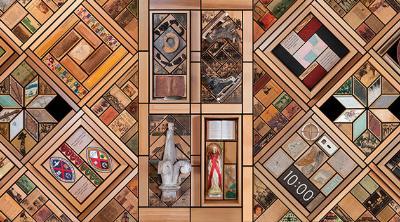The residential school system is one of the worst atrocities in Canadian history. Designed to assimilate Indigenous peoples into Canadian society, it actually represented a cruel form of genocide. It resulted in a systematic attempt by the Canadian government and various churches in Canada, including the Catholic Church and Anglican Church, to destroy the culture, beliefs, ways of being, and ways of knowing of Indigenous peoples. This genocide of identity and culture is an abhorrent and embarrassing period of history for Canada, with a far-reaching impact on Indigenous peoples today. The effects of the system linger in many Indigenous communities and issues of resentment, poverty, and loss of identity continue to plague many Indigenous peoples.
The Witness Blanket
 The Witness Blanket is a national monument of the residential school system. Artist and master carver Carey Newman was inspired by a woven blanket to create a large-scale art installation from items reclaimed from residential schools, churches, and traditional and cultural entities, Band Offices, treatment centres and universities across Canada. The blanket stands to honour the children and the survivors through acknowledgment of the atrocities of the residential school era. It is an important symbol of the reconciliation process that creates an entry point for witnesses to contribute further. It is a symbol of reconciliation.
The Witness Blanket is a national monument of the residential school system. Artist and master carver Carey Newman was inspired by a woven blanket to create a large-scale art installation from items reclaimed from residential schools, churches, and traditional and cultural entities, Band Offices, treatment centres and universities across Canada. The blanket stands to honour the children and the survivors through acknowledgment of the atrocities of the residential school era. It is an important symbol of the reconciliation process that creates an entry point for witnesses to contribute further. It is a symbol of reconciliation.
To learn more, visit the Witness Blanket project website or download the Witness Blanket app from the iTunes store.
Teaching and Learning Centre's Witness Blanket curriculum
To consider the impact of the Witness Blanket in relation to UFV's Board Policy on Fulfilling Our Commitment to Aboriginal Peoples, the Teaching and Learning Centre has developed a curriculum for use by faculty and departments.
We encourage you to incorporate an activity or series of activities into your classes. Learners will have the opportunity to:
- Identify the circumstances of Indigenous peoples in relation to residential schools.
- Examine the impact of residential schools on Indigenous peoples and others in Canada.
- Envision their personal role in reconciliation.
